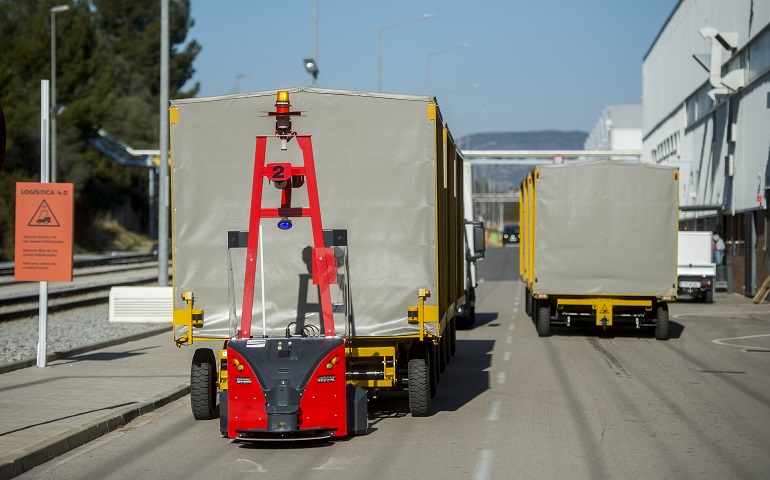Covering almost 240 km per day, these autonomous robots communicate with surroundings and even regulate traffic to increase safety
Seat has employed 8 autonomous robots at the Martorell plant to ply within, and even on the road, to transport parts between workshops. This autonomy has helped shift more than 2,000 parts per day outside of the workshops. This is an absolutely excellent use of autonomy which will further support developing systems to improve delivery efficiency. These robots can be seen hauling cargo through pedestrian and vehicle traffic, communicating with each other, and their surroundings without any humans controlling them. It is efficient, clean and will generate a large chunk of usable data that can be studied by engineers to further the cause for autonomy in other sectors.
Automated Guided Vehicles (AGV)
Seat clearly mentions these programmable autonomous robots perform a variety of heavy operations without human support inside the workshops. Now, the latest advancements in SLAM navigation recognition (simultaneous localisation and mapping), 4G connection, and induction electric battery charging have further enhanced their capabilities to go beyond the shop floor and function on the roads as well. There are no guidance systems or cables tethered to these AGVs. Working in convoys, each set can transport 10 tonnes and together they transport up to 2,000 parts per day. The sophisticated brains are able to read and adapt to their surroundings. While defining routes, first they are guided and then they memorise it utilising an integrated camera. Once they record the set route it becomes a matter of repeating the same every time they are hauling parts. As put by Seat – they leave the base, see a two-storey building on their left, then an intersection, where they turn right… one reference point after another until they reach their destination. They keep scanning for these reference points, and if one becomes blocked for some reason, they wait for it to be clearly visible again.
4G Connectivity
The intercommunication between these AGVs is supported by 4G technology allowing them to communicate with their surroundings and even each other. All eight robots do not move at the same time, when one leaves the loading area it notifies the next one in the waiting area to replace its place. If their paths cross, they notify each other to slow down in order to avoid collisions. They are even able to regulate traffic in their path by changing traffic lights to amber in their favour as they have right of way. Sensors located at the top and at ground level make it stop if it detects any object in its path. AGVs travel at a speed of 1 metre per second. A slower speed means they are able dead stop in front of any object or person within a radius of one and a half metres.
Sustainable
As these AGVs run smoothly throughout their delivery objective, efficiency goes up thus reducing the CO2 footprint against other hauling alternatives between workshops. They run on electric power and have induction charging capabilities doing away with cable charging. The battery gets fully charged in 15 minutes which is done while they are stopped to load parts onto them. Seat claims utilising clean energy allows a reduction of 1.5 tons of CO2 per year. “In recent years #seat has been incorporating pioneering innovations in the area of logistics and this is yet another example of our commitment to becoming a benchmark of Industry 4.0. Using AGV enables us to optimise production and logistics processes in an efficient, sustainable, and connected way” mentions Vice-president for Production and Logistics Dr Christian Vollmer.
By Abhijeet Singh
Source: https://autotechreview.com
CUT COTS OF THE FLEET WITH OUR AUDIT PROGRAM
The audit is a key tool to know the overall status and provide the analysis, the assessment, the advice, the suggestions and the actions to take in order to cut costs and increase the efficiency and efficacy of the fleet. We propose the following fleet management audit.





